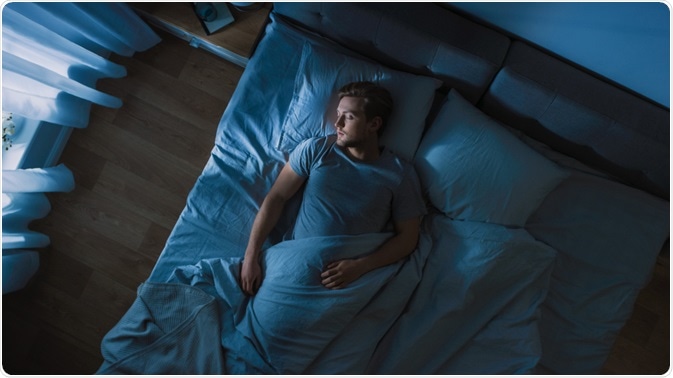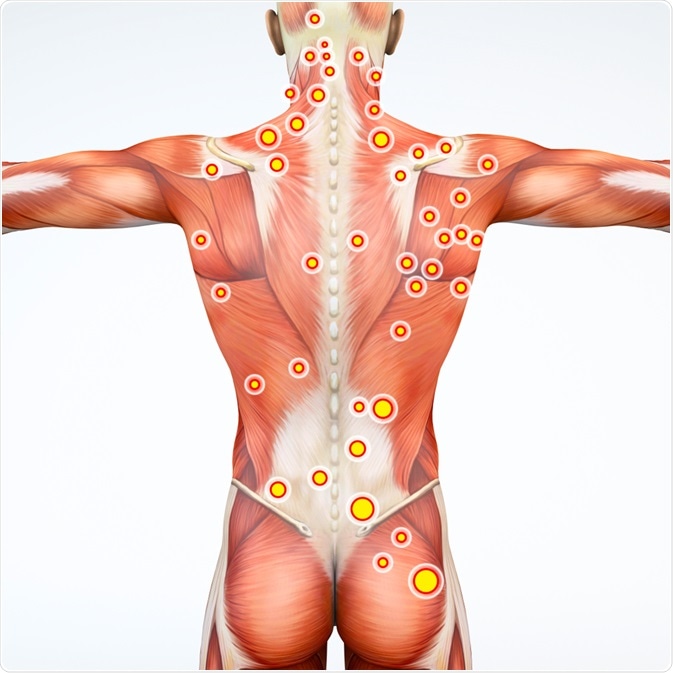Approximately one-third of UK adults have sleep problems. The long-term consequences of poor sleep include executive function impairments and increased risk of diabetes, heart disease, and obesity.

Image Credit: Gorodenkoff/Shutterstock.com
Instead of opting for medication, research has shown that pressure points can boost several sleep parameters.
What are Pressure Points?
The fundamental principles of pressure points, also known as acupressure, are similar to acupuncture. While acupuncture aims to alleviate pain through the insertion of fine needles into the body, acupressure is less invasive.
It involves applying pressure to specific parts of the body called acupoints or pressure points positioned along the meridians. Whereby meridians are bodily channels that help maintain Qi (pronounced “chi”).
Ancient Chinese Medicine argues that if properties such as Qi, Yin, Yang, and internal organs are not functioning adequately or in harmony with each other, then abnormalities can arise, including insomnia and restlessness. However, the stimulation of pressure points helps restore the inner balance of the body by increasing the flow of Qi energy.
As a result, it can also retain or improve health. Every meridian is linked to several tissues and organs. The stimulation of specific meridians reduces pain, both locally and diffusely, from other body parts.
The techniques used to stimulate pressure points can be employed by both medical practitioners and patients and is effective in alleviating several adverse symptoms, including fatigue and sleep quality.

Image Credit: Naeblys/Shutterstock.com
Using Pressure Points to Get a Better Night’s Sleep
The following pressure point areas have been found to improve sleep quality.
HT7 Pressure Point
The Shen Men pressure point (indexed at HT7), also known as the spirit gate, is situated on the Heart Meridan of Hand-Shaoyin. Specifically, it is located on the crease of the wrist of the inner arm, below the fifth digit. The pathway is considered to be associated with consciousness, mood, vitality, and thought and has been associated with improved sleep.
A longitudinal study investigating the impact of HT7 acupressure for care residents with insomnia reported improved insomnia during the intervention period and in two weeks post-intervention.
The intervention group received acupressure over five weeks on the HT7 points of both wrists, while the control group only received light touches at the same spots.
Following the two-weeks post-intervention, levels of insomnia began to increase. This suggests that the continued use of acupressure at the HT7 pressure point is needed to maintain improvements in sleep quality.
Similar results were found in a study examining the effectiveness of an 8-week acupressure intervention on insomnia in those with Alzheimer’s disease.
The results showed that after receiving the treatment on the HT7 pressure point, participants reported a greater number of effective hours of sleep, improved sleep, and a reduction in the time taken to fall asleep.
If wishing to stimulate this pressure point, face your palm upward and place the thumb of your opposite hand on your wrist underneath your fifth digit. Apply firm pressure using your thumb for several minutes.
GB20, ST6, and P6 Pressure Points
The Gallbladder 20 (GB20), Stomach 6 (ST6), and Nei Guan (P6) have also been linked to improved sleep. In a sample of cardiac surgery patients, the effectiveness of acupressure on the points mentioned above on anxiety and sleep quality post-surgery was analyzed.
At three days postoperative, patients in the intervention group were administered 16 minutes of acupressure once a day for three days.
Compared to the control group, those undergoing acupressure reported significantly improved sleep quality following repeated administrations. The intervention was found particularly useful for women and regular smokers.
Nei Guan pressure point is positioned on the inner arm approximately three finger widths below the wrist between the tendons of the flexor carpi radialis and the palmarislongus.
Clenching the fist and turning the palm upwards, can make the tendons appear more prominent and the pressure point easier to find. Using the thumb of the opposing hand, apply pressure between the two tendons.
As well as improving sleep quality, acupressure of the P6 has been found to improve fatigue. A randomized control trial investigating the effect of self-administered acupressure on fatigue and sleep in patients with migraines found that compared to a sham acupressure group, those in acupressure groups reported significantly lower fatigue.
TF4, AT4, C015, and CO18 Pressure Points
A pilot, randomized control trial, investigated the impact of acupressure in patients with ovarian cancer on the following pressure points on the ear: the Shen Men TF4; Pizhixia AT4; Neifenmi (CO18) and Xin (CO15).
In the study, the control group received sleep hygiene practices, while the intervention group received this in addition to acupressure on the pressure points in the ear. Sleep quality was assessed during four specific timepoints.
Those in the intervention group reported a 65% reduction in sleep disturbance between the first two assessment time points and in the subsequent four weeks following treatment. A further 10% reduction was also reported between time three- and six-weeks post-intervention.
If you are looking to improve your sleep, the Shen Men is situated in the upper third of the ear and can be stimulated by gently massaging the area.
The Importance of Sleep
Approximately a third of adults in the United Kingdom suffer from poor sleep. However, the impact of long-term poor sleep quality is vast.
After several nights of poor sleep, concentration, decision making, and mood can be impaired.
In the long-term, it can put individuals at more risk of reduced life expectancy, diabetes, obesity, and heart disease. Therefore, it is essential to get approximately eight hours of good quality sleep per night.
References and Further Reading
- Vagharseyyedin, S. A., Salmabadi, M., BahramiTaghanaki, H., & Riyasi, H. (2019). The impact of self-administered acupressure on sleep quality and fatigue among patients with migraine: A randomized controlled trial. Complementary therapies in clinical practice, 35, 374-380. Doi: 10.1016/j.ctcp.2018.10.011
- Mehta, P., Dhapte, V., Kadam, S., & Dhapte, V. (2017). Contemporary acupressure therapy: Adroit cure for painless recovery of therapeutic ailments. Journal of traditional and complementary medicine, 7(2), 251-263. Doi: 10.1016/j.jtcme.2016.06.004
- Sun, J. L., Sung, M. S., Huang, M. Y., Cheng, G. C., & Lin, C. C. (2010). Effectiveness of acupressure for residents of long-term care facilities with insomnia: a randomized controlled trial. International Journal of Nursing Studies, 47(7), 798-805. Doi: 10.1016/j.ijnurstu.2009.12.003
- Simoncini, M., Gatti, A., Quirico, P. E., Balla, S., Capellero, B., Obialero, R., … & Pernigotti, L. M. (2015). Acupressure in insomnia and other sleep disorders in elderly institutionalized patients suffering from Alzheimer’s disease. Aging clinical and experimental research, 27(1), 37-42. Doi: 10.1007/s40520-014-0244-9
- Aygin, D., & Şen, S. (2019). Acupressure on Anxiety and Sleep Quality After Cardiac Surgery: A Randomized Controlled Trial. Journal of PeriAnesthesia Nursing, 34(6), 1222-1231. Doi: 10.1016/j.jopan.2019.03.014
- Kuo, H. C., Tsao, Y., Tu, H. Y., Dai, Z. H., & Creedy, D. K. (2018). Pilot randomized controlled trial of auricular point acupressure for sleep disturbances in women with ovarian cancer. Research in nursing & health, 41(5), 469-479. Doi: 10.1002/nur.21885
- NHS (2018). Why lack of sleep is bad for your health. https://www.nhs.uk/live-well/sleep-and-tiredness/why-lack-of-sleep-is-bad-for-your-health/
Further Reading
- All Sleep Content
- What is Sleep?
- Types of Sleep Disorders
- Promoting Sounder Sleep in Older Adults
- Sleep Deprivation – Inadequate Quantity of Sleep
Last Updated: Oct 29, 2020
Source: Read Full Article